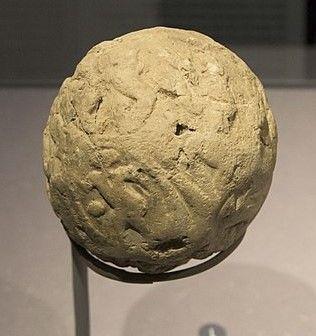Did Sumerian tokens precursor blockchain?

Surprisingly, blockchain technology has 6,000-year-old roots in Sumerian culture, and ‘signed’ symbols representing assets are as old as commerce.
The blockchain is all about signature. Where there is trust in signature, there can be finance. Finance is an abstraction of assets, and claims are a basic form of finance.
Consider bankless days in ancient history when Sumerians used things like “tokens” and “bullas” to manage commerce. Tokens, excavated from Mesopotamian ruins, were small coin-size pieces of clay with various markings used to represent the owner’s commodities, like grain and sheep.
In many cases, tokens were found sealed within clay envelopes or bullas, that were artistically crafted and “signed” with a custom inscription detailing contents.
An ancient bulla was kept in the temple and could then be used to claim assets.
A digital wallet is a form of the ancient bulla, as it contains and may sign for current digital assets. But most digital wallets do not have simple mechanisms for signed contingent claims on assets.
We at Bulla Network have updated this ancient idea by creating a protocol of signed claims. We call it the Bulla Protocol, and it works like this: If a signed claim is deemed true by its intended counterparty (and is signed by the same), the Bulla Protocol triggers an on-chain, wallet-to-wallet transaction. If this transaction is completed, the protocol signs the total claim as paid and updates the particular claimant’s Bulla token.
The use of a token to manage and offset claims along with a function to pay is called ‘triple entry accounting’. The Bulla Protocol tokenizes triple entry accounting. The invention is a claims settlement alternative to banks. It is also ‘native’ to the blockchain. Any wallet owner may create and own any number of claims bullas. By doing this, they are creating their own claims NFT.
BullaBanker is the first of Arkitoken’s collaborative DeFi apps. A BullaBanker NFT allows its owner to manage invoices and remittances with other bankless people. The token is owned by the creator, is transparent, inexpensive to use and easily accessed by digital crypto wallets.
The externality to using claims bullas? The creation of Bulla Network. A wallet can see both its own credits and debits on-chain via its and other people’s Bulla claims tokens — all without a bank.
Additional DeFi apps coming soon from Bulla Network include FriendLend, BNPL and Bulla links (for tip jar payments).
Learn more here: Bulla.network.
References https://upload.wikimedia.org/wikipedia/commons/7/79/Clay_Bulla_3200_BCE_Susa_Iran_01.jpg
Hnapel, CC0, via Wikimedia Commons
Bulla: https://en.wikipedia.org/wiki/Bulla_(seal)
Rai Stones: https://medium.com/the-capital/the-tale-of-stone-money-and-how-it-resembles-bitcoin-66526f37e97